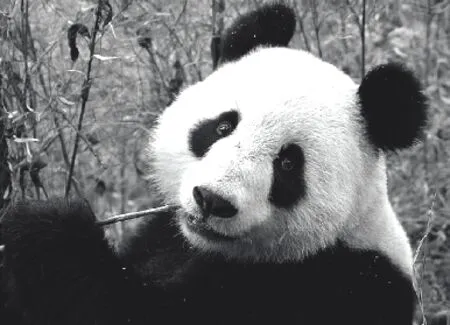倚竹为生的大熊猫
2017-05-04byanonymous
by anonymous
翻译:常青 吴雨奇
倚竹为生的大熊猫
The Bamboo Bear
by anonymous
翻译:常青 吴雨奇

相信童鞋们都很喜欢大熊猫吧?可不是嘛,它们那圆乎乎、毛茸茸的可爱样儿让人想不爱都难!不过,除了大熊猫的可爱,你们还了解它们多少呢?
For a long time, scientists weren’t sure if giant pandas were bears, or perhaps they were more closely related toraccoons.Now we know that giant pandas are1)indeedmembers of the bear family.They are similar to other bears in their general looks and the way they walk and climb.
Bamboo is the most important plant in a giant panda’s life.They spend at least 12 hours each day eating bamboo.Pandas2)graspbamboo3)stalkswith their fve fngers and a specialwrist bone.They use their teeth topeel offthe toughouter layersof the stalk, so they can4)revealthe soft inner5)tissue.What’s more, they also eat the leaves.
Know More
raccoon(浣熊),原产自北美洲,现为无危物种。浣熊的特征是眼睛周围有一圈深色皮毛,身型较小,体长约40到70厘米。由于浣熊常在河边捕食鱼类,人们误以为它们是在水中浣洗食物,故名浣熊。
1 ) indeed [ɪn΄diːd] adv.的确,实际上
2 ) grasp [ɡrɑːsp] v.紧抓,紧握
3 ) stalk [stɔːk] n.(植物的)茎,杆,梗
4 ) reveal [rɪ΄viːl] v.显露,展现出
5 ) tissue [΄tɪ∫uː] n.(动植物的)组织
词组加油站
wrist bone腕骨
peel off剥掉(外层或覆盖物),
把……表皮剥掉
outer layer外层


Giant pandas are only about the size ofa stick ofbutter at birth, and they’re6)hairlessand helpless.The panda mother gives great care to her tiny7)cub.She usually8)cradlesit in one9)pawand holds it close to her chest.For several days after birth, the mother won’t leave the10)den, and she won’t even eat or drink!



长期以来,科学家们都难以确定大熊猫到底是属于熊类,还是其实与浣熊有着更加接近的血缘关系。现在我们知道了,大熊猫确实是熊类家族的成员呢。它们有着与其他熊类相似的长相和攀爬方式。
在大熊猫的一生中,竹子是最为重要的植物。它们每天至少要花上12个小时吃竹子。熊猫会运用它们独特的腕骨,用五根手指头抓着竹茎,然后用牙齿剥去竹茎坚韧的外皮,让竹茎里的软组织显露出来。此外,熊猫还会吃竹叶。
刚出生的熊猫宝宝大约只有一块黄油那么大,它们全身都没长毛,也无法自理。熊猫妈妈会悉心照料它的小宝宝,它通常会用一只爪子抱着宝宝,让宝宝紧紧依偎在自己的胸前。在熊猫宝宝出生后的数天里,熊猫妈妈都不会离开自己的窝,甚至还会不吃不喝呢!
词组加油站
a stick of一块,一片,一条
6 ) hairless [΄heələs] adj.无毛的 7) cub [kʌb] n.幼兽,幼仔 8) cradle [΄kreɪdl] v.(小心轻柔地)抱着
9 ) paw [pɔː] n.爪子,脚爪 10) den [den] n.兽穴,兽窝
